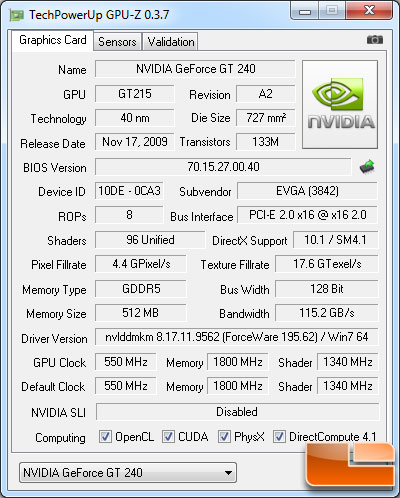EVGA GT 240 Overclocking

When it comes to overclocking, the EVGA GeForce GT 240 Superclocked edition is already factory overclocked, but only the memory is overclocked. The core clock speed is 550MHz with a shader clock of 1340MHz, which is identical to the NVIDIA reference cards. The only thing really overclocked on the Superclocked version of the EVGA GeForce GT 240 is the GDDR5 memory. Rather than having a 1700MHz memory clock frequency (3400MHz effective) the memory speed has been increased by 100MHz. This means that the memory clock speed is 1800MHz (3600MHz effective), which increases the memory bandwidth from 54.4 GB/s to 57.4 GB/s. This is a modest performance increase on a card that has Superclocked in its name, so we wanted to push the card even harder. In order to do this we fired up EVGA's Precision overclocking utility that comes on the driver disc.

The EVGA Precision overclocking utility gives you the ability to overclock the core, shader and memory clock frequencies and to manually adjust the fan to any speed your little heart desires. The only thing it doesn't do is give you the ability to adjust the voltages on the video cards!

We pushed the limits of the card and found the highest that we could get it was 665MHz on the core with the shaders locked at 1810MHz. This is an impressive increase of 470MHz on the shader clock and a 115MHz boost on the core clock of this GeForce GT 240 graphics card. Even the 55MHz bump on the memory was fairly decent, but we focused more on the core clock and shader clock than anything since with the overclocked GDDR5 memory the card really isn't memory limited by any means. The overclock really helped performance as in Furmark we went from 26FPS to 34FPS at a resolution of 1920x1200! This is a nearly a 31% boost in performance on this already 'overclocked' card, so you can see that this card has some hidden performance under the hood.

As we ran more games and applications with the shader clock frequency at 1820MHz we found that not everything was 100% stable with the 96 unified shaders running that fast. For example, we had to back the shaders down to 1750MHz on 3DMark Vantage in order for the benchmark to complete. Even backing it down one level the performance increase was still present. The overall score in 3DMark Vantage with Extreme settings jumped up to X2443 from X2112. Not as big of a jump as we saw in Furmark, but it still is a 16% performance increase. Overclocking the EVGA GeForce GT 240 Superclocked Edition video card showed that we could easily get 15-30% more performance out of the card while keeping the fan speed set to auto.


